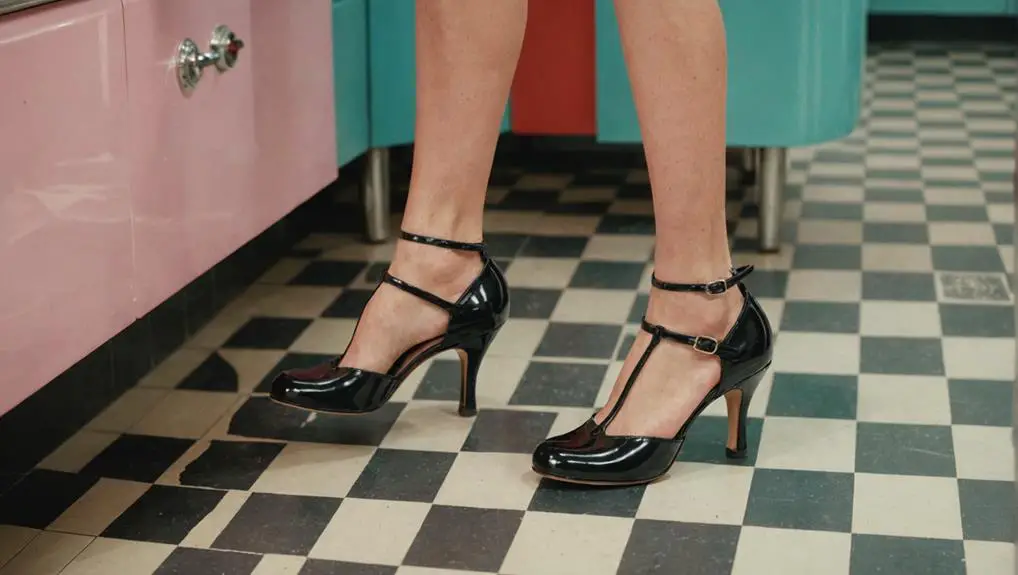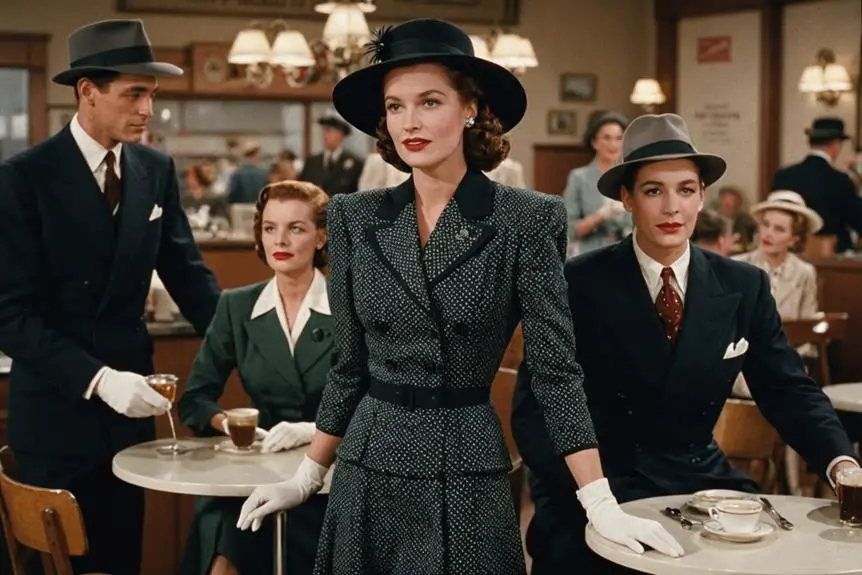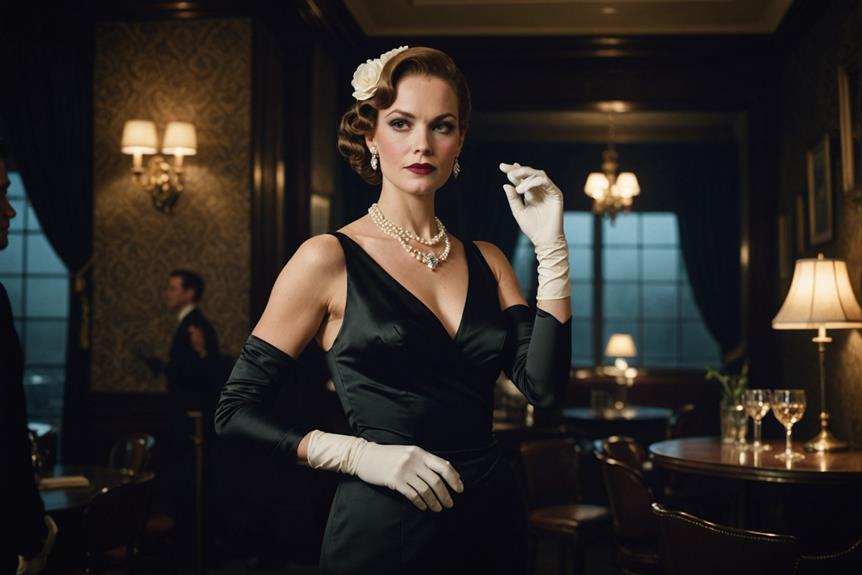Women's T-strap heels in the 1950s symbolized elegance and newfound empowerment. You'd see them paired with the era's popular flared skirts and tailored dresses, enhancing the feminine silhouette. Influenced by stars like Marilyn Monroe, these heels showcased confidence and individuality. Their distinctive vertical strap offered support while maintaining style, available in leather and suede with charming embellishments. As T-strap heels became dance and formal event staples, they reflected broader cultural shifts surrounding women's roles. Their vintage charm continues to inspire modern designs, and discovering their journey could deepen your appreciation for this timeless footwear.
Historical Context of T-Strap Heels
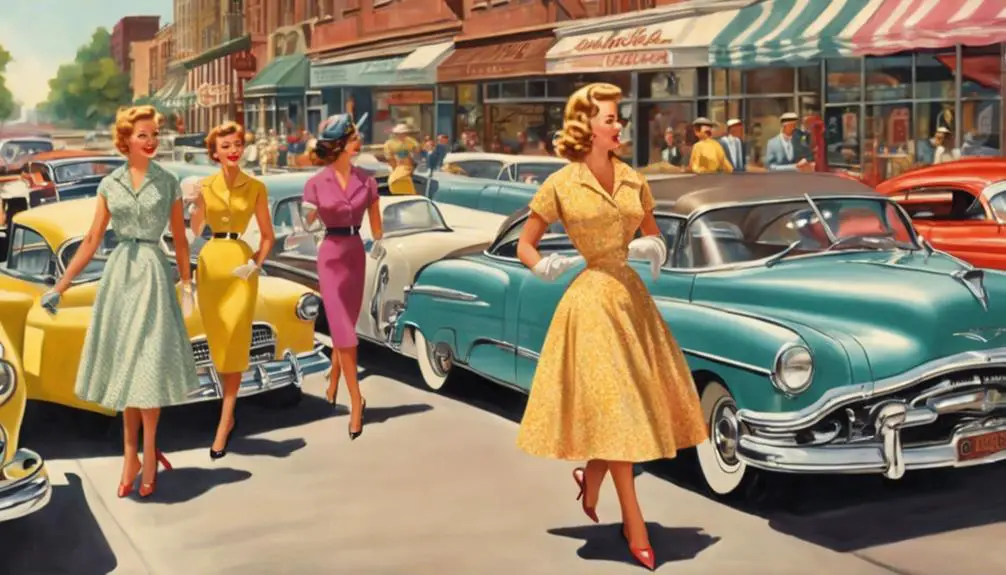
As women's roles evolved during the early to mid-20th century, T-strap heels emerged as a symbol of both style and liberation. Gaining traction in the 1920s and solidifying their status through the 1950s, these shoes resonated with the cultural shifts of the time. The T-strap design became emblematic of the flapper culture, blending elegance with comfort—a reflection of women's increasing independence and desire for self-expression. The popularity of T-strap heels was also influenced by vintage clothing trends, as collectors sought pieces that highlighted unique designs and craftsmanship, often characterized by distinctive labels from the era, such as those from vintage designers.
As you explore the historical backdrop of T-strap heels, you'll notice how they complemented the shorter hemlines of 1950s fashion, enhancing feminine silhouettes while allowing women to move with ease. This practical yet stylish footwear became a staple in vintage collections, demonstrating how societal changes influenced fashion choices. Iconic figures from film and music, frequenting boutiques like Paradise Bootery, helped popularize T-strap heels, cementing their place in fashion history.
Crafted from luxurious leather and often adorned with decorative elements, these shoes showcased an era committed to quality and style. Within this framework, T-strap heels symbolize not just a fashion statement, but a pivotal moment in women's liberation, allowing women to confidently navigate both social and professional spheres.
Key Design Elements
T-strap heels from the 1950s showcase a blend of elegance and functionality that defines their enduring appeal. The distinctive vertical strap not only adds a stylish touch but also provides essential support, often enhanced by an ankle strap for added security. Crafted from high-quality leather and suede, these shoes exhibit a variety of textures that resonated with the fashion sensibilities of the era.
| Design Element | Description |
|---|---|
| Strap Design | Vertical T-strap with ankle strap |
| Materials | Leather and suede |
| Heel Heights | Ranged from kitten to stiletto |
| Embellishments | Rhinestones and decorative buckles |
The heel heights varied, catering to diverse preferences and occasions. Many designs included embellishments that enhanced their visual appeal, making them versatile for both casual and formal wear. You could easily pair T-strap heels with flared skirts or tailored dresses, emphasizing the feminine silhouette that was so popular during the decade. Overall, these key design elements contribute to the lasting charm and functionality of T-strap heels, solidifying their place in fashion history.
Fashion Influence in the 1950s
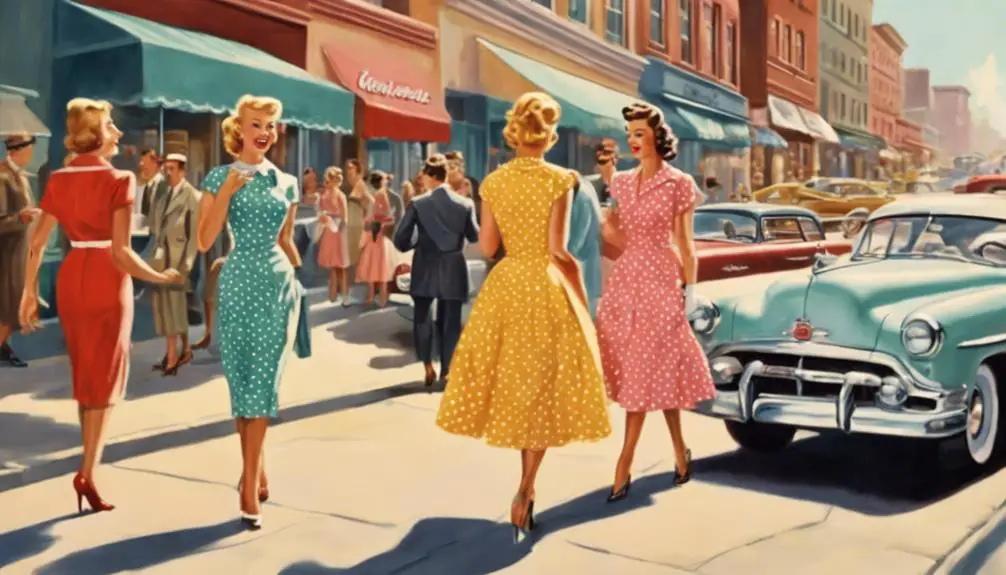
The 1950s ushered in a transformative era for women's fashion, characterized by a newfound embrace of femininity and elegance. During this decade, T-strap heels emerged as a fashionable staple, seamlessly blending style with comfort. These shoes were not just footwear; they symbolized a shift towards more liberated expressions of femininity.
Consider the following influences on fashion during the 1950s:
- Feminine Silhouettes: T-strap heels complemented tea-length dresses and skirts, enhancing the hourglass figure that defined the era.
- Celebrity Endorsement: Iconic stars and musicians showcased T-strap heels, making them a must-have for both casual outings and formal events.
- Comfort Meets Style: The central strap design provided support, allowing women to navigate their daily lives without sacrificing fashion.
- Cultural Shift: As women embraced their femininity, T-strap heels became an expression of newfound confidence and freedom.
These elements combined to make T-strap heels an essential part of women's shoes in the 1950s, reflecting the decade's focus on elegance while allowing for personal style and expression.
Notable Cultural Associations
During the 1950s, cultural associations surrounding T-strap heels evolved considerably, intertwining with the decade's social and artistic movements. These fashionable silhouettes became emblematic of the era's liberation, reflecting a shift from the restrictive footwear of previous decades. T-strap heels offered a blend of elegance and comfort, allowing women to express their newfound empowerment and individuality.
Iconic figures like Marilyn Monroe and Audrey Hepburn donned T-strap shoes, solidifying their place in pop culture and inspiring countless women to adopt this stylish accessory. The heels also found a home in the burgeoning pin-up culture, where they became synonymous with playful femininity and flirtation. Women embraced T-straps as a statement piece, signaling a departure from traditional norms and showcasing their confidence.
As you explore the impact of T-strap heels during this transformative decade, consider how these shoes not only enhanced fashionable silhouettes but also played an essential role in the evolving narrative of women's empowerment. They symbolize a time when women began to assert their identities through fashion, celebrating both style and self-expression in a rapidly changing world.
Vintage Collections and Styles

As women's empowerment flourished in the 1950s, so did the allure of vintage collections featuring T-strap heels, which became a staple in many wardrobes. The combination of elegance and comfort made these heels ideal for various occasions, especially formal and dance events. Crafted from high-quality materials like leather and suede, these shoes reflected the era's commitment to craftsmanship and durability. Understanding the importance of tag identification can also enhance appreciation for these vintage styles, as labels provide insights into the history and value of footwear.
The designs of T-straps were often adorned with embellishments that enhanced their vintage appeal. You'll find that:
- Rhinestones added a touch of glamour, making them perfect for evening wear.
- Floral patterns brought a feminine charm, complementing the era's silhouettes.
- Iconic brands like Henri Flatow produced styles that gained popularity among celebrities, adding to their cultural significance.
- Pairings with tea-length dresses and skirts emphasized the overall vintage aesthetic, making the T-strap a versatile choice.
These elements contributed to the enduring allure of T-strap heels, as they not only represented fashion but also embodied the spirit of a transformative decade in women's history. Vintage collections of these heels remain coveted for their timeless elegance and craftsmanship.
Modern Revivals and Interpretations
While many fashion trends fade with time, the resurgence of T-strap heels in contemporary design showcases a compelling blend of nostalgia and modernity. Contemporary designers have breathed new life into the beloved 1950s style, utilizing modern materials and aesthetics to attract today's fashion-forward audience.
These modern T-strap heels often retain classic features, such as ankle straps and elegant silhouettes, but they come in an array of colors and patterns to cater to diverse tastes. Vintage-inspired collections frequently highlight T-strap designs, reflecting a continued fascination with their historical significance and timeless appeal.
Fashion enthusiasts love pairing T-strap heels with both casual and formal outfits, emphasizing their versatility in enhancing feminine silhouettes.
| Feature | Modern T-Strap Heels |
|---|---|
| Materials | Leather, Vegan Options |
| Colors | Bold, Pastels, Neutrals |
| Occasions | Casual, Formal |
| Designers | High-End, Indie Brands |
This revival in retro fashion has prominently showcased T-strap heels in seasonal fashion shows, signaling their enduring popularity and relevance in today's style landscape.
Frequently Asked Questions
What Era Are T Strap Heels From?
T-strap heels originated in the 1920s, gaining prominence through flapper culture. Their elegant design persisted, and by the 1950s, they became essential, enhancing women's fashion with their feminine flair and versatile appeal across various occasions.
What Are Heels With Straps Called?
Heels with straps are commonly called strap heels. They include variations like T-straps, ankle straps, and Mary Janes, each offering unique styles and support while enhancing the overall look of your outfit.
What Were the Most Popular Shoes in the 50s?
In the 50s, you'd find a diverse range of footwear, including elegant high heel pumps, practical Oxfords, chic Mary Janes, and stylish T-straps, all catering to the decade's unique fashion and social dynamics.
When Were Pointy Heels Popular?
Pointy heels gained popularity in the 1950s, becoming a fashion staple. You'll notice how they elongate the legs, reflecting the sleek silhouettes favored during this era, driven by influential designers and iconic film figures.
